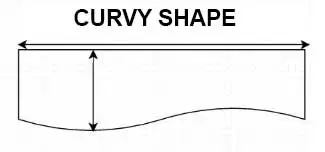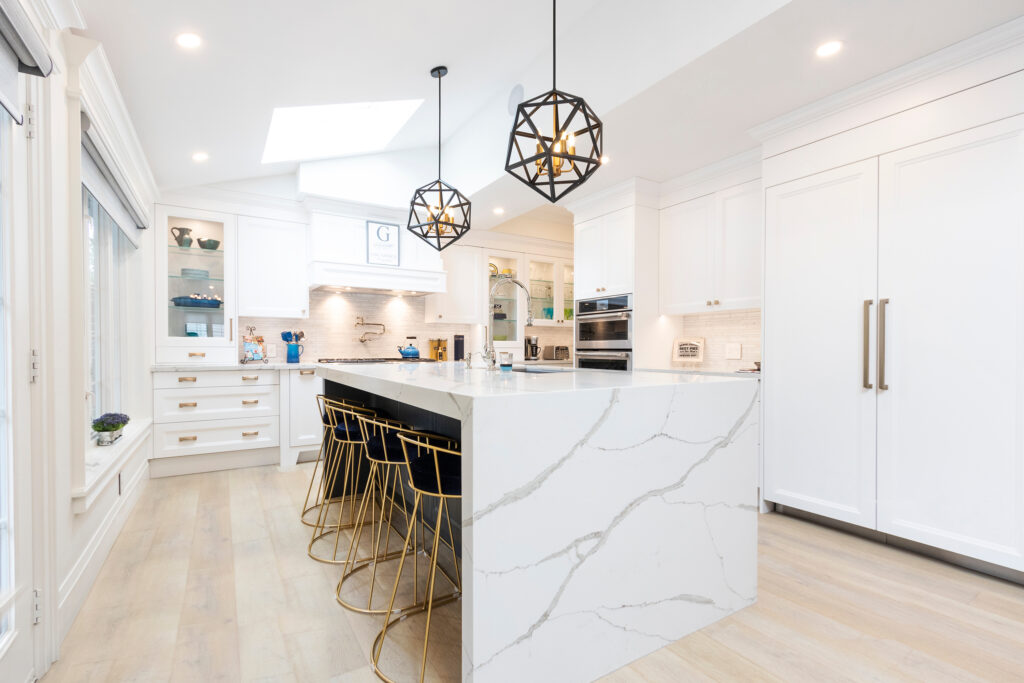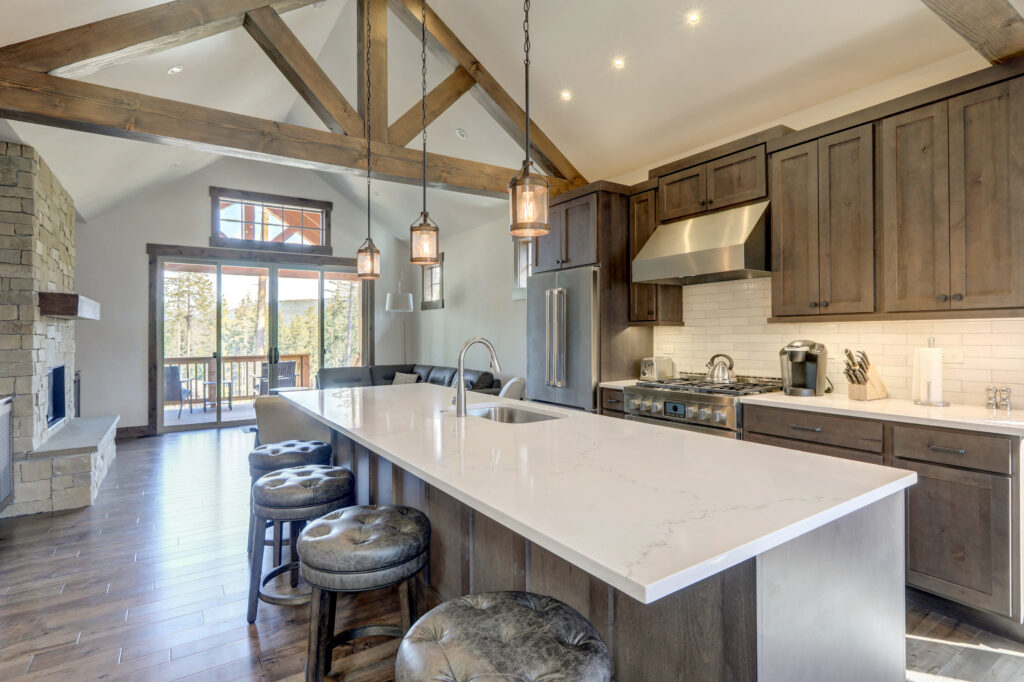How to Measure Countertops: Complete Step-by-Step Guide
Learning how to measure countertops accurately helps you estimate renovation costs and avoid ordering too much or too little material. Whether you’re planning granite, quartz, marble, or quartzite countertops, proper measurements are essential.
This guide walks you through creating a basic sketch, taking accurate measurements, and understanding how countertop materials are calculated. With simple tools and basic math, you’ll confidently measure your kitchen or bathroom countertops.
Why Accurate Countertop Measurements Matter
Countertops represent 10-15% of your kitchen renovation budget. For a $30,000 remodel, that’s $3,000-$4,500 spent on countertops alone.
Benefits of Proper Measurements:
- Accurate cost estimates before committing to purchase
- Avoid ordering excess material (wasted money)
- Prevent shortage delays during installation
- Speed up the quote process with fabricators
- Better planning for backsplash and edge details
According to the National Kitchen & Bath Association, proper planning prevents 80% of common renovation problems.
Tools Needed to Measure Countertops
Gather these simple tools before starting:
- Measuring Tape: 25-foot tape measure works for most kitchens
- Pen or Pencil: For marking measurements on your sketch
- Paper: Graph paper makes sketching easier but isn’t required
- Calculator: For converting measurements and calculating square footage
- Smartphone Camera: Take photos to reference later
Step 1: Create a Basic Sketch
Start by drawing a simple overhead view of your counter space. This doesn’t need to be perfectly to scale—it’s just a reference for recording measurements.
What to Include:
- Basic shape of each countertop section
- Approximate locations of sinks, cooktops, and stoves
- Islands or peninsulas (draw separately)
- Any angled or curved edges
- Exposed edges that will need finishing
Pro Tip: Draw each countertop section as a separate shape. L-shaped counters become two rectangles, for example.
Step 2: Measure Length and Width
Now measure each section of countertop:
Standard Measurements:
- Depth (Width): Standard base cabinets are 24 inches deep
- Overhang: Add 1-1.5 inches to depth for standard overhang
- Total Standard Width: 25-25.5 inches including overhang
- Length: Measure the full length of each counter section
Measuring Tips:
- Measure in inches first, convert to feet later if needed
- Always round UP to the nearest inch
- Measure twice to ensure accuracy
- Don’t double-measure corner areas where sections meet
- Account for walls, appliances, and other obstacles
Write each measurement clearly on your sketch.
Step 3: Mark Sink and Cooktop Locations
Accurately marking cutout locations helps fabricators provide better estimates.
Sink Measurements:
- Drop-In Sinks: Measure outer rim dimensions
- Undermount Sinks: Measure bowl opening dimensions
- Farmhouse Sinks: Measure front-to-back depth and width
- Note distance from sink to nearest edges
Cooktop/Stove Considerations:
- Measure cutout dimensions if separate cooktop
- For ranges, mark where countertop ends on both sides
- Note any required clearances for knobs or controls
These cutouts affect material costs since fabricators charge for complex cutting work.
Step 4: Identify Finished Edges
Exposed edges require polishing and finishing, which adds to your project cost.
Common Finished Edge Locations:
- Island or peninsula ends
- Countertops next to appliances (refrigerators, dishwashers)
- Breakfast bar overhangs
- Any edge not against a wall or cabinet
Mark these locations on your sketch with a different color or symbol. Learn about edge design options to choose your preferred style.
How to Measure Countertops with Odd Shapes
Not all countertops are simple rectangles. Here’s how to handle unique shapes:
Curved or Wavy Edges
Measure the curve at its widest point, then measure the full length. Fabricators cut these as one solid piece, so you need the maximum dimensions.
Angled Corners
Break angled sections into triangles. Measure the two perpendicular sides, then calculate the diagonal if needed.
L-Shaped Counters
Measure as two separate rectangles. Be careful not to double-count the corner area where they meet.
Islands with Overhangs
Measure the main counter area, then add extra width for seating overhangs (typically 10-15 inches beyond the base cabinet).
Converting Measurements to Square Footage
Countertops are priced per square foot. Here’s how to calculate:
Formula: Length (inches) × Width (inches) ÷ 144 = Square Feet
Example Calculation:
- Counter section: 96 inches long × 25.5 inches wide
- 96 × 25.5 = 2,448 square inches
- 2,448 ÷ 144 = 17 square feet
Add all sections together for total square footage.
Don’t Forget to Subtract:
- Sink cutout areas
- Cooktop openings
- Stove gaps (no countertop)
However, many fabricators quote based on full slabs used rather than exact square footage.
Understanding Slab Sizes
Most natural stone and quartz materials are sold by the slab:
Standard Slab Dimensions:
- Granite/Quartzite: Approximately 105″ × 56″ (41 square feet)
- Quartz: Approximately 120″ × 56″ (46 square feet)
- Marble: Varies, often 100″ × 50″ (35 square feet)
If you need 50 square feet of granite, you’ll purchase two slabs (82 square feet total). Leftover material can be used for backsplash, bathroom vanities, or cutting boards.
Compare pricing for different materials in our guides:
Additional Considerations When You Measure Countertops
Backsplash Planning
If using matching material for backsplash:
- Standard height: 4 inches
- Full height: 18-20 inches (behind stove)
- Measure total linear feet of backsplash needed
- Use leftover slab material to save money
Overhang Requirements
Standard overhangs don’t require support, but larger ones do:
- Standard overhang: 1-1.5 inches (no support needed)
- Seating overhang: 10-12 inches (support required)
- Bar overhang: 15-18 inches (corbels or brackets needed)
Note overhang requirements on your sketch as they affect both material and installation costs.
Seam Locations
Large counters require seams where slabs join. Fabricators minimize visible seams, but you should know:
- L-shaped kitchens typically need one seam at the corner
- Long straight runs over 10 feet require seams
- Island tops over 8 feet often need seams
- Seams affect final appearance and cost
Regional Pricing Considerations for VA/WV
Northern Virginia (Sterling, Fairfax, Arlington)
Average Installed Costs:
- Granite: $50-95 per square foot
- Quartz: $65-110 per square foot
- Marble: $75-130 per square foot
- Quartzite: $85-160 per square foot
Visit our Sterling VA showroom to see materials and get precise quotes.
West Virginia (Martinsburg, Charleston)
Average Installed Costs:
- Granite: $45-85 per square foot
- Quartz: $60-100 per square foot
- Marble: $70-120 per square foot
- Quartzite: $80-150 per square foot
Our Martinsburg WV location serves the tri-state area with competitive pricing.
Professional vs. DIY Measurements
Your DIY measurements help with budgeting, but professional fabricators always take final measurements before cutting.
Why Professional Measurement Matters:
- Ensures perfect fit (within 1/16 inch tolerance)
- Accounts for wall irregularities
- Identifies potential installation challenges
- Creates templates for complex shapes
- Guarantees proper support calculations
At Craft Countertops, we provide free professional measurement once you’ve selected your material. This ensures perfect results every time.
Common Measurement Mistakes to Avoid
1. Forgetting Overhangs: Always add 1-1.5 inches to cabinet depth.
2. Double-Counting Corners: Where two sections meet, measure each side separately without overlap.
3. Ignoring Wall Irregularities: Walls aren’t always straight; professionals account for this.
4. Rounding Down: Always round measurements UP to avoid material shortage.
5. Measuring Only Once: Always measure twice to catch errors.
6. Forgetting Cutouts: Mark all sink, cooktop, and outlet locations.
Frequently Asked Questions About Measuring Countertops
How accurate do my measurements need to be?
Your initial measurements should be within an inch for budgeting purposes. Professional fabricators take precise measurements (within 1/16 inch) before cutting your actual countertops.
Can I measure countertops by myself?
Yes! One person can measure countertops with a 25-foot measuring tape. However, having a second person hold the tape makes it easier, especially for long sections.
Do I measure inside or outside cabinet dimensions?
Measure the outside edge of your base cabinets, then add 1-1.5 inches for standard overhang. This gives you the countertop dimensions, not cabinet dimensions.
How do I calculate square footage for pricing?
Multiply length × width in inches, then divide by 144 to convert to square feet. Add all sections together, then subtract sink and cooktop cutouts. See our quartz cost guide for pricing details.
What if my kitchen has unusual angles or curves?
Measure at the widest points and mark the unusual features clearly on your sketch. Fabricators are experienced with complex shapes and will take detailed templates during professional measurement.
How much extra should I order for waste?
Don’t add extra—fabricators account for waste in their quotes. You purchase full slabs regardless, and leftover material can be used for backsplash or other projects.
Do islands count as separate measurements?
Yes, measure islands separately from perimeter counters. They’re often cut from different slab pieces and may have different edge treatments or overhangs.
Should I include backsplash in my measurements?
Measure backsplash separately as linear feet along walls. Standard 4-inch backsplash typically uses leftover material from your countertop slabs.
How long does professional measurement take?
Professional templating takes 30-60 minutes for an average kitchen. Fabricators create precise templates using laser measuring tools and physical templates for sinks and cooktops.
Get Started with Your Countertop Project
Now that you know how to measure countertops, you’re ready for the next step:
What to Do Next:
- Complete Your Measurements: Use this guide to create your sketch
- Choose Your Material: Visit our showrooms to see options in person
- Request a Quote: We’ll provide accurate pricing based on your measurements
- Schedule Professional Measurement: We verify dimensions before cutting
- Enjoy Your New Countertops: Professional installation ensures perfect results
Get Your Free Countertop Quote
Visit Our Showrooms:
- Sterling, VA: 14 Bryant Ct Suite C, Sterling, VA 20166
- Martinsburg, WV: 718 Foxcroft Ave, Martinsburg, WV 25401
Bring your measurements and we’ll help you:
- Select the perfect countertop material
- Review hundreds of colors and patterns
- Choose edge profiles
- Get accurate pricing for your project
- Schedule professional measurement and installation
Contact us today to start your countertop project.
Serving Virginia, West Virginia, Maryland, and Washington DC with quality countertops since 1992.
Read our comprehensive guides:




